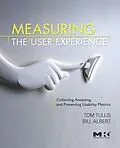Measuring the User Experience provides the first single source of practical information to enable usability professionals and product developers to effectively measure the usability of any product by choosing the right metric, applying it, and effectively using the information it reveals. Authors Tullis and Albert organize dozens of metrics into six categories: performance, issues-based, self-reported, web navigation, derived, and behavioral/physiological. They explore each metric, considering best methods for collecting, analyzing, and presenting the data. They provide step-by-step guidance for measuring the usability of any type of product using any type of technology. This book is recommended for usability professionals, developers, programmers, information architects, interaction designers, market researchers, and students in an HCI or HFE program. - Presents criteria for selecting the most appropriate metric for every case - Takes a product and technology neutral approach - Presents in-depth case studies to show how organizations have successfully used the metrics and the information they revealed
Autorentext
Bill Albert is Director of the Design and Usability Center at Bentley University. Prior to joining Bentley, Bill was Director of User Experience at Fidelity Investments, Senior User Interface Researcher at Lycos, and Post-Doctoral Research Scientist at Nissan Cambridge Basic Research. Bill is an Adjunct Professor in Human Factors in Information Design at Bentley University and a frequent instructor at the International Usability Professional's Association Annual Conference. Bill has published and presented his research at more than thirty national and international conferences. He is coauthor (with Tom Tullis) of Measuring the User Experience and Beyond the Usability Lab. He is on the editorial board for the Journal of Usability Studies.
Klappentext
Measuring the User Experience provides the first single source of practical information to enable usability professionals and product developers to effectively measure the usability of any product by choosing the right metric, applying it, and effectively using the information it reveals.
Authors Tullis and Albert organize dozens of metrics into six categories: performance, issues-based, self-reported, web navigation, derived, and behavioral/physiological. They explore each metric, considering best methods for collecting, analyzing, and presenting the data. They provide step-by-step guidance for measuring the usability of any type of product using any type of technology.
This book is recommended for usability professionals, developers, programmers, information architects, interaction designers, market researchers, and students in an HCI or HFE program.
. Presents criteria for selecting the most appropriate metric for every case. Takes a product and technology neutral approach
. Presents in-depth case studies to show how organizations have successfully used the metrics and the information they revealed
Inhalt
Introduction; Background: Data Types; Sampling Size; Experimental Design; Data Analysis. Overview of Usability Metrics: Types of Metrics; Methods and Metrics; Summative vs. Formative; Choosing Appropriate Metrics. Performance Metrics: Task Success; Completion Time; Errors; Efficiency (clicks, pages, steps, etc.). Issues-Based Metrics: What is a Usability Issue; Severity Ratings; Test Biases; Reporting Positive Issues. Peferential-Based Metrics: Satisfaction; Ease of Use, Usefulness; Expectations; Standard Questionnaires. Web Navigation Metrics: Web-page Click-through Rates; Web page Abandonment Rates. Derived Metrics: Task-based; Aggregate. Observational Metrics: Eye Movements; Stress; Facial Expressions; Other Observational Metrics. Case Studies. Special Topics: Six Sigma and Usability; Automated Methods; Discount Techniques; Server Log Analysis; A/B Testing. Conclusion: Communication to Management; Cost Justification; Industry Trends.
